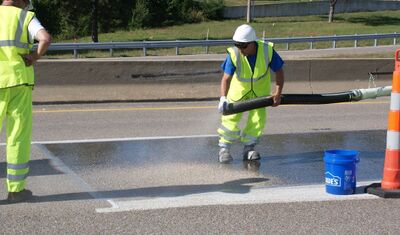Category:628 High Friction Surface Treatment
| Additional Information |
| * ATSSA, a nonstandard Job Special Provision for HFST |
| * Every Day Counts (EDC) 2012 Initiatives |
| * FHWA's HFST FAQs |
| * FHWA Brochure |
| * Using High Friction Surface Treatments to Improve Safety at Horizontal Curves, a Texas A&M Transportation Institute (TTI) report |
| * Accelerating Innovation Deployment (AID) Application |
High Friction Surface Treatments (HFST) can improve wet crash locations as well as locations that would benefit from increases in friction due to polishing or the geometry of the roadway.
Maintaining the appropriate amount of pavement friction is critical for safe driving. In locations where drivers may brake excessively, for example, when going around curves, down hills or steep grades, or when approaching an intersection, the road surface can become prematurely polished, reducing the pavement friction and allowing vehicles to skid when the drivers brake. Wet road surfaces can lead to lower friction resulting in skidding or hydroplaning. Refer to the Every Day Counts (EDC) 2012 Initiatives website. HFST can improve wet crash locations as well as locations that would benefit from increases in friction due to the geometry of the roadway.
High Friction Surface Treatments place a thin layer of specially engineered, durable, high friction aggregates as a topping on a thermosetting polymer resin binder – usually polymeric, modified polyester, or urethane. These aggregate systems have a long lasting skid resistance and also make the overlay much more resistant to wear and polishing. The resin or polymer binder combination locks the aggregate firmly in place, creating an extremely rough, hard, durable surface capable of withstanding everyday roadway demands such as heavy braking and even snowplowing. HFST restores pavement surface friction characteristics where traffic has worn down existing pavement surface aggregates. HFST can also help compensate for inadequate geometric designs such as sharp curves and/or substandard or variable superelevations. Refer to FHWA's HFST FAQs website.
Missouri’s first HFST was placed on US 54 in Jefferson City in the fall of 2013. This location had a history of wet weather crashes. Several low to mid-cost safety improvements were tried, but over time were not able to alleviate all wet weather incidents. This project and three others in the Central District were paid by a Highways for Life grant. Due to the success of these projects, Missouri applied for and received federal funding to install HFST in every district through the Accelerating Innovation Deployment (AID) grant.
Placement of HFST
Curves
The following table is from Using High Friction Surface Treatments to Improve Safety at Horizontal Curves, a July 2012 Texas A&M Transportation Institute report. It provides guidance on the location to begin placement in advance of the PC of a curve. The approach speed should be the operating speed as determined by a field analysis, and the curve speed is the posted advisory speed. Engineering judgment and field evaluation should be used to determine the beginning and the length of the treatment. The HFST can often be ended at the PT.
| Approach Speed (mph) | Curve Speed (mph) | ||||||
|---|---|---|---|---|---|---|---|
| 30 | 35 | 40 | 45 | 50 | 55 | 60 | |
| 35 | 35 | ||||||
| 40 | 76 | 41 | |||||
| 45 | 122 | 86 | 46 | ||||
| 50 | 173 | 138 | 97 | 51 | |||
| 55 | 230 | 194 | 154 | 108 | 57 | ||
| 60 | 292 | 257 | 216 | 170 | 119 | 62 | |
| 65 | 359 | 324 | 284 | 238 | 186 | 130 | 68 |
Intersections
Stopping sight distance can be used to determine the length of the HFST prior to an intersection. However, if frequent back-ups occur, it might be necessary to increase the length of the HFST upstream of the intersection. EPG 230.2.5 Stopping Sight Distance and K Factors provides guidance on stopping sight distance.
Grades
Table 3-36 (involves grade), from A Policy on Geometric Design of Highways and Streets, 2011 (the Green Book)
Table 3-34 (no grade change), from A Policy on Geometric Design of Highways and Streets, 2011 (the Green Book)

